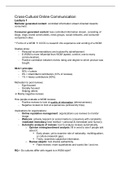Cross-Cultural Online Communication
Lecture 1
Marketer generated content: controlled information stream directed towards
consumers.
Consumer generated content: less controlled information stream, consisting of
blogs, vlogs, brand communities, news groups, social networks, and consumer
comparison sites.
^ Forms of e-WOM CCOC is research into experience and wording of e-WOM.
Studies show:
- Personal recommendations are trustworthy advertisement.
- E-WOM is more influential than WOM (speed, comfort, one-to-many
communication).
- Positive correlation between review rating and degree to which product was
bought.
90-9-1 principle:
- 90% = lurkers
- 9% = intermittent contributors (10% of reviews).
- 1% = heavy contributors (90%).
Motivation to post reviews:
- Ego-focused
- Socially focused
- Helping others
Mainly negative reviews
How people evaluate e-WOM reviews:
- Positive reviews to look at quality of information (driers/cameras).
- Negative reviews to look at experiences (airlines/city trips).
Implications for organizations:
- Online reputation management: organizations use reviews to monitor
image.
- Webcare: actively respond on social media to consumers with complaints
(mediated immediacy best method = personal & immediate (and humor)).
- Automatic analysis of reviews: tool to analyze reviews automatically.
o Opinion mining/sentiment analysis: fill in word to see if people talk
about it.
Early phase, yet to examine role of nationality, multilingualism,
or culture (research gap).
Tricky: examines subjective information.
o Review skeptic: tool checks authenticity.
Fake reviews: more superlatives and words like I and me.
RQ = Do cultures differ with regard to e-WOM style?
, Lecture 2
Reviews are about (EDPOIAC):
- Expressiveness
- Directness
- Politeness
- Openness
- Individualism
- Avoidance of insecurity
- Context
Model of influence: culture, individual, and e-WOM communication influence each
other.
E. T. Hall Iceberg model
Visible:
- Artifacts
- Behavior
Invisible:
- Norms
- Beliefs
- Assumptions
- Values
E. T. Hall (1980) 3 dimensions:
1. Proxemics: relate to people in daily lives.
2. Monochromous (fixed) vs. polychromous (fluid)
3. High-context (implicit, rely on context) vs. low-context (explicit comm.)
Criticism E.T. Hall:
- He only used observations and anecdotal evidence (qualitative)
- Outdated
Hofstede’s 6 dimensions:
1. Individualism vs. collectivism: people’s self-image.
2. Masculinity (achievement, heroism, assertiveness, material awards,
competitive) vs. femininity (cooperation, modesty, caring for weak, quality of
life)
3. Long-term oriented society (maintain traditions) vs. short-term oriented
societies (prepare for future, open to change)
4. Indulgence (relatively free satisfaction, enjoying life) vs. restraint
(suppresses satisfaction, strict social norms)
5. Power distance index (degree less powerful accept and expect power to be
distributed unequally)
6. Uncertainty avoidance index (degree members of society feel
uncomfortable with uncertainty and ambiguity)
a. Strong UA: maintain rigid codes of beliefs & behavior, intolerant for the
unorthodox.
b. Weak UA: relaxed attitude, practice counts more than principle.





